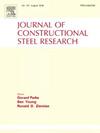Experimental investigation on cyclic behavior of concrete-filled round-ended stainless steel tubular columns
IF 4
2区 工程技术
Q1 CONSTRUCTION & BUILDING TECHNOLOGY
引用次数: 0
Abstract
This paper presents a comprehensive investigation into the cyclic behavior of four concrete-filled round-ended stainless steel tubular (CFRSST) columns and two concrete-filled round-ended carbon steel tubular (CFRCST) columns. Experimental results revealed that the CFRSST specimens exhibited local buckling, steel tube fracture, weld failure, and concrete crushing at the column base. The hysteretic loops were full without significant pinching, indicating excellent ductility and energy dissipation. Compared to CFRSST columns under weak axis bending, those under strong axis bending demonstrated higher initial stiffness, bearing capacity, and superior ductility ratio and energy dissipation. CFRSST columns with stainless steel tubes outperformed CFRCST columns with carbon steel tubes in terms of ductility and energy dissipation, while maintaining similar capacity and initial stiffness. Furthermore, CFRSST columns with hollow sections exhibited higher bearing capacity, initial stiffness, ductility, and energy dissipation under strong axis bending. However, hollow-section CFRSST columns demonstrated lower ductility and energy dissipation than their solid-section counterparts. Refined finite element (FE) models of CFRSST columns were developed and validated against experimental data. Further parametric analyses were conducted to assess the effects of concrete strength, steel tube strength (both outer and inner), and steel tube thickness on the cyclic behavior of CFRSST columns. A predictive method for calculating the bearing capacity of CFRSST columns is proposed, with calculated results closely matching the experimental data.
求助全文
约1分钟内获得全文
求助全文
来源期刊

Journal of Constructional Steel Research
工程技术-工程:土木
CiteScore
7.90
自引率
19.50%
发文量
550
审稿时长
46 days
期刊介绍:
The Journal of Constructional Steel Research provides an international forum for the presentation and discussion of the latest developments in structural steel research and their applications. It is aimed not only at researchers but also at those likely to be most affected by research results, i.e. designers and fabricators. Original papers of a high standard dealing with all aspects of steel research including theoretical and experimental research on elements, assemblages, connection and material properties are considered for publication.
 求助内容:
求助内容: 应助结果提醒方式:
应助结果提醒方式:


